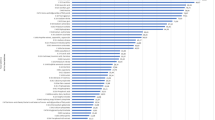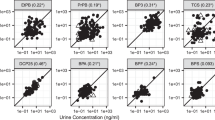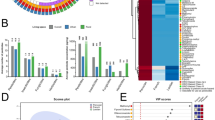Abstract
An organic diet may reduce dietary exposure to pesticides but findings based on observational data are scant. We aimed to compare urinary pesticide concentrations between “organic” and “conventional” consumers from the NutriNet-Santé study. Organic food consumption was determined using a self-reported food frequency questionnaire. Individuals with a proportion of organic food in the whole diet (in g/d) below 10% were defined as low organic food consumers and those whose proportion was above 50% as high organic food consumers. A propensity score matching procedure was then used to obtain two similar subsets of 150 participants, differing mostly by the organic valence of their diet. Urinary pesticide and metabolite concentrations (organophosphorus, pyrethroid, and azole compounds) were determined by UPLC-MS/MS, standardized with respect to creatinine. The molar sums of total diethylphosphates, dimethylphosphates, and dialkylphosphates were also computed. Differences in distributions across groups were tested using Wilcoxon signed-rank test for matched data. Mean age was 58.5 years and 70% of participants were women. Significantly lower urinary levels of diethylthiophosphate, dimethylthiophosphate, dialkylphosphates, and free 3-phenoxybenzoic acid were observed among organic consumers compared to conventional consumers. Our findings confirm that exposure to certain organophosphate and pyrethroïd pesticides in adults may be lowered by switching from conventional to organic foods. This is particularly of high interest among conventional fruit and vegetable consumers, as their exposure may be the highest.
This is a preview of subscription content, access via your institution
Access options
Subscribe to this journal
Receive 6 print issues and online access
$259.00 per year
only $43.17 per issue
Buy this article
- Purchase on Springer Link
- Instant access to full article PDF
Prices may be subject to local taxes which are calculated during checkout


Similar content being viewed by others
References
Kim K-H, Kabir E, Jahan SA. Exposure to pesticides and the associated human health effects. Sci Total Environ. 2017;575:525–35.
Mostafalou S, Abdollahi M. Pesticides: an update of human exposure and toxicity. Arch Toxicol. 2017;91:549–99.
Nicolopoulou-Stamati P, Maipas S, Kotampasi C, Stamatis P, Hens L Chemical Pesticides and Human Health: The Urgent Need for a New Concept in Agriculture. Front Public Health 2016; 4. https://doi.org/10.3389/fpubh.2016.00148.
Guyton KZ, Loomis D, Grosse Y, El Ghissassi F, Benbrahim-Tallaa L, Guha N, et al. Carcinogenicity of tetrachlorvinphos, parathion, malathion, diazinon, and glyphosate. Lancet Oncol. 2015;16:490–1.
Mnif W, Hassine AIH, Bouaziz A, Bartegi A, Thomas O, Roig B. Effect of endocrine disruptor pesticides: a review. Int J Environ Res Public Health. 2011;8:2265–303.
Mostafalou S, Abdollahi M. Pesticides and human chronic diseases: evidences, mechanisms, and perspectives. Toxicol Appl Pharmacol. 2013;268:157–77.
Casals-Casas C, Desvergne B. Endocrine disruptors: from endocrine to metabolic disruption. Annu Rev Physiol. 2011;73:135–62.
Thayer KA, Heindel JJ, Bucher JR, Gallo MA. Role of environmental chemicals in diabetes and obesity: a National Toxicology Program workshop review. Environ Health Perspect. 2012;120:779.
Collectif INSERM. Pesticides: Effets sur la santé, une expertise collective de l’Inserm. Salle Presse Inserm. 2013.http://presse.inserm.fr/pesticides-effets-sur-la-sante-une-expertise-collective-de-linserm/8463/ (accessed 21 Aug2016).
Eurostat. Agriculture, forestry and fishery statistics. 2016.
Nougadère A, Sirot V, Kadar A, Fastier A, Truchot E, Vergnet C, et al. Total diet study on pesticide residues in France: levels in food as consumed and chronic dietary risk to consumers. Environ Int. 2012;45:135–50.
Union Européenne. Pesticides database. 2016.ec.europa.eu/food/plant/pesticides/eu-pesticides-database/public/.
Barański M, Średnicka-Tober D, Volakakis N, Seal C, Sanderson R, Stewart GB et al. Higher antioxidant and lower cadmium concentrations and lower incidence of pesticide residues in organically grown crops: a systematic literature review and meta-analyses. Br J Nutr 2014;112(5):794–811.
Lairon D. Nutritional quality and safety of organic food. A review. Agron Sustain Dev. 2010;30:33–41.
Smith-Spangler C, Brandeau ML, Hunter GE, Bavinger JC, Pearson M, Eschbach PJ, et al. Are organic foods safer or healthier than conventional alternatives?A systematic review. Ann Intern Med. 2012;157:348–66.
Authority (EFSA) EFS. Monitoring data on pesticide residues in food: results on organic versus conventionally produced food. EFSA Support Publ. 2018;15:1397E.
Bradman A, Quirós-Alcalá L, Castorina R, Aguilar Schall R, Camacho J, Holland NT et al. Effect of organic diet intervention on pesticide exposures in young children living in low-income urban and agricultural communities. Environ Health Perspect. 2015. https://doi.org/10.1289/ehp.1408660.
Curl CL, Fenske RA, Elgethun K. Organophosphorus pesticide exposure of urban and suburban preschool children with organic and conventional diets. Environ Health Perspect. 2002;111:377–82.
Lu C, Toepel K, Irish R, Fenske RA, Barr DB, Bravo R. Organic diets significantly lower children’s dietary exposure to organophosphorus pesticides. Environ Health Perspect. 2006;114:260–3.
Curl CL, Beresford SAA, Fenske RA, Fitzpatrick AL, Lu C, Nettleton JA, et al. Estimating pesticide exposure from dietary intake and organic food choices: The Multi-Ethnic Study of Atherosclerosis (MESA). Environ Health Perspect. 2015. https://doi.org/10.1289/ehp.1408197
Oates L, Cohen M, Braun L, Schembri A, Taskova R. Reduction in urinary organophosphate pesticide metabolites in adults after a week-long organic diet. Environ Res. 2014;132:105–11.
Agence Bio/CSA. Baromètre de consommation et de perception des produits biologiques en France, 13ème édition. 2016.http://www.agencebio.org/sites/default/files/upload/documents/4_Chiffres/BarometreConso/1400610_agence_bio_rapport_2015_vp.pdf (accessed 11 Aug2016).
Dickson-Spillmann M, Siegrist M, Keller C. Attitudes toward chemicals are associated with preference for natural food. Food Qual Prefer. 2011;22:149–56.
Grunert KG. Food quality and safety: consumer perception and demand. Eur Rev Agric Econ. 2005;32:369–91.
Hoefkens Christine, Verbeke Wim, Aertsens Joris, Mondelaers Koen, Van Camp John. The nutritional and toxicological value of organic vegetables: Consumer perception versus scientific evidence. Br Food J. 2009;111:1062–77.
Hughner RS, McDonagh P, Prothero A, Shultz CJ, Stanton J. Who are organic food consumers? A compilation and review of why people purchase organic food. J Consum Behav. 2007;6:94–110.
Padilla Bravo C, Cordts A, Schulze B, Spiller A. Assessing determinants of organic food consumption using data from the German National Nutrition Survey II. Food Qual Prefer. 2013;28:60–70.
Hercberg S, Castetbon K, Czernichow S, Malon A, Mejean C, Kesse E, et al. The Nutrinet-Santé Study: a web-based prospective study on the relationship between nutrition and health and determinants of dietary patterns and nutritional status. BMC Public Health. 2010;10:242.
Lassale C, Galan P, Julia C, Fezeu L, Hercberg S, Kesse-Guyot E. Association between adherence to nutritional guidelines, the metabolic syndrome and adiposity markers in a french adult general population. PLoS ONE. 2013;8:e76349.
Lassale C, Péneau S, Touvier M, Julia C, Galan P, Hercberg S, et al. Validity of web-based self-reported weight and height: results of the Nutrinet-Santé study. J Med Internet Res. 2013;15:e152.
Baudry J, Méjean C, Allès B, Péneau S, Touvier M, Hercberg S, et al. Contribution of Organic Food to the Diet in a Large Sample of French Adults (the NutriNet-Santé Cohort Study). Nutrients. 2015;7:8615–32.
Kesse-Guyot E, Castetbon K, Touvier M, Hercberg S, Galan P. Relative validity and reproducibility of a food frequency questionnaire designed for French adults. Ann Nutr Metab. 2010;57:153–62.
Ali MS, Groenwold RH, Klungel OH. Best (but oft-forgotten) practices: propensity score methods in clinical nutrition research. Am J Clin Nutr. 2016;104:247–58.
Bouatra S, Aziat F, Mandal R, Guo AC, Wilson MR, Knox C, et al. The Human Urine Metabolome. PLoS ONE. 2013;8:e73076.
GEMS/Food-Euro. Second workshop on reliable evaluation of low-level contamination of food. Report on a workshop in the frame of GEMS/Food-Euro, EUR/HFA target 22. 26-27 May 1995. Kulmbach, German. Geneva: WHO. 1995.
Estaquio C, Kesse-Guyot E, Deschamps V, Bertrais S, Dauchet L, Galan P, et al. Adherence to the French Programme National Nutrition Santé Guideline Score is associated with better nutrient intake and nutritional status. J Am Diet Assoc. 2009;109:1031–41.
Baudry J, Allès B, Péneau S, Touvier M, Méjean C, Hercberg S et al. Dietary intakes and diet quality according to levels of organic food consumption by French adults: cross-sectional findings from the NutriNet-Santé Cohort Study. Public Health Nutr 2017;20:638–48.
Lu C, Barr DB, Pearson MA, Waller LA. Dietary intake and its contribution to longitudinal organophosphorus pesticide exposure in urban/suburban children. Environ Health Perspect. 2008;116:537–42.
Griffith W, Curl CL, Fenske RA, Lu CA, Vigoren EM, Faustman EM. Organophosphate pesticide metabolite levels in pre-school children in an agricultural community: Within- and between-child variability in a longitudinal study. Environ Res. 2017;20(4):638–48.
Fréry N, Saoudi A, Garnier R, Zeghnoun A, Falq G, Guldner L. Exposure of the French population to environmental pollutants–Environmental components of the French National Survey on Nutrition and Health–Initial results. Fr Inst Public Health Surveill St.-Maurice. Fra. 2010.
Andreeva VA, Deschamps V, Salanave B, Castetbon K, Verdot C, Kesse-Guyot E, et al. Comparison of Dietary Intakes Between a Large Online Cohort Study (Etude NutriNet-Santé) and a Nationally Representative Cross-Sectional Study (Etude Nationale Nutrition Santé) in France: Addressing the Issue of Generalizability in E-Epidemiology. Am J Epidemiol. 2016;184:660–9.
Sudakin DL, Stone DL. Dialkyl phosphates as biomarkers of organophosphates: The current divide between epidemiology and clinical toxicology. Clin Toxicol. 2011;49:771–81.
Acknowledgements
We thank all the people who helped carry out the NutriNet-Santé study and all the dedicated and conscientious volunteers. We especially thank Younes Esseddik, Paul Flanzy, Véronique Gourlet, Nathalie Arnault, Fabien Szabo, Laurent Bourhis and Cédric Agaesse.
Author contributions
The author contributions were as follows: JPC, SH, EKG, DL and PG conceived and designed the experiments. JB performed the experiments. GD and AD performed the urinary dosages. JB and EKG analyzed the data. JB and EKG wrote the paper. All the authors were involved in interpreting results and editing the manuscript. JB and EKG had primary responsibility for final content. All authors read and approved the final manuscript.
Funding
The BioNutriNet project was supported by the French National Research Agency (Agence Nationale de la Recherche) in the context of the 2013 Programme de Recherche Systèmes Alimentaires Durables (ANR-13-ALID-0001). The NutriNet-Santé cohort study is funded by the following public institutions: Ministère de la Santé, Santé Publique France, Institut National de la Santé et de la Recherche Médicale (INSERM), Institut National de la Recherche Agronomique (INRA), Conservatoire National des Arts et Métiers (CNAM) and Paris 13 University. The funders had no role in study design, data collection and analysis, decision to publish, or preparation of the manuscript.
Author information
Authors and Affiliations
Corresponding author
Ethics declarations
Conflict of interest
DL acts since 2018 as a scientific expert, with no honoraria or personal funding, in two non-for-profit foundations recently funded in France («Fondation Bjorg, Bonneterre et citoyens » and « Fond de dotation Institut de l’alimentation bio »).
Electronic supplementary material
Rights and permissions
About this article
Cite this article
Baudry, J., Debrauwer, L., Durand, G. et al. Urinary pesticide concentrations in French adults with low and high organic food consumption: results from the general population-based NutriNet-Santé. J Expo Sci Environ Epidemiol 29, 366–378 (2019). https://doi.org/10.1038/s41370-018-0062-9
Received:
Revised:
Accepted:
Published:
Issue Date:
DOI: https://doi.org/10.1038/s41370-018-0062-9
Keywords:
This article is cited by
-
Urinary dialkylphosphate metabolites in the assessment of exposure to organophosphate pesticides: from 2000 to 2022
Environmental Monitoring and Assessment (2024)
-
Environmental pressures and pesticide exposure associated with an increase in the share of plant-based foods in the diet
Scientific Reports (2023)
-
Organic food consumption and the incidence of cancer in the Danish diet, cancer and health cohort
European Journal of Epidemiology (2023)
-
Reported organic food consumption and metabolic syndrome in older adults: cross-sectional and longitudinal analyses
European Journal of Nutrition (2022)
-
Quantifiable urine glyphosate levels detected in 99% of the French population, with higher values in men, in younger people, and in farmers
Environmental Science and Pollution Research (2022)



